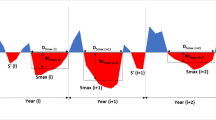Abstract
A variety of indices for characterising hydrological drought have been devised which, in general, are data demanding and computationally intensive. On the contrary, for meteorological droughts very simple and effective indices such as the Standardised Precipitation Index (SPI) have been used. A methodology for characterising the severity of hydrological droughts is proposed which uses an index analogous to SPI, the Streamflow Drought Index (SDI). Cumulative streamflow is used for overlapping periods of 3, 6, 9 and 12 months within each hydrological year. Drought states are defined which form a non-stationary Markov chain. Prediction of hydrological drought based on precipitation is also investigated. The methodology is validated using reliable data from the Evinos river basin (Greece). It can be easily applied within a Drought Watch System in river basins with significant storage works and can cope with the lack of streamflow data.
Similar content being viewed by others
References
Ben-Zvi A (1987) Indices of hydrological drought in Israel. J Hydrol 92(1–2):179–191
Beran MA, Rodier JA (1985) Hydrological aspects of drought. In: UNESCO–WMO Studies and Reports in Hydrology 39:149
Bonaccorso B, Bordi I, Cancelliere A, Rossi G, Sutera A (2003) Spatial variability of drought: an analysis of the SPI in Sicily. Water Resour Manag 17:273–296
Clausen B, Pearson CP (1995) Regional frequency analysis of annual maximum streamflow drought. J Hydrol 173:111–130
Cordery I, McCall M (2000) A model for forecasting drought from teleconnections. Water Resour Res 36:763–768
Correia FN, Santos MA, Rodrigues R (1987) Engineering risk in regional drought studies. In: Duckstein L, Plate EJ (Eds) Engineering, reliability and risk in water resources. Proc. of ASI Tucson Arizona USA 1985 Martinus Ninjhoff Pub
Domonkos P (2003) Recent precipitation trends in Hungary in the context of larger scale climatic changes. Nat Hazards 29:255–271
Edwards DC, McKee TB (1997) Characteristics of 20th century drought in the United States at multiple time scale. Climatology Report 97-2. Colorado State University, Fort Collins, Colorado
Efstratiadis A, Nalbantis I, Mamassis N (2000) Hydrometeorological data processing. In: Modernisation of the supervision and management of the water resource system of Athens, Report 8:129 pages. Department of Water Resources, Hydraulic and Maritime Engineering—National Technical University of Athens, Athens
Hayes M, Wilhite DA, Svoboda M, Vanyarkho O (1999) Monitoring the 1996 drought using the standardized precipitation index. Bull Am Meteorol Soc 80:429–438
Lloyd-Hughes B, Saunders MA (2002) A drought climatology for Europe. Int J Climatol 22:1571–1592
Lohani VK, Loganathan GV (1997) An early warning system for drought management using the Palmer drought index. J Am Water Resour Assoc 33(6):1375–1386
Lohani VK, Loganathan GV, Mostaghimi S (1998) Long-term analysis and short-term forecasting of dry spells by the Palmer drought severity index. Nord Hydrol 29(1):21–40
McKee TB, Doeskin NJ, Kleist J (1993) The relationship of drought frequency and duration to time scales. In: Proceedings of the eighth conference on applied climatology, Anaheim, CA, January 17–23, 1993. American Meteorological Society Boston MA, pp 179–184.
Min SK, Kwon WT, Park EH, Choi Y (2003) Spatial and temporal comparisons of droughts over Korea with East Asia. Int J Climatol 23:223–233
Nalbantis I (1995) Use of multiple-time-step information in rainfall-runoff modelling. J Hydrol 165:135–159
Ntale HK, Gan T (2003) Drought indices and their application to East Africa. Int J Climatol 23:1335–1357
Ochola WO, Kerkides P (2003) A Markov chain simulation model for predicting critical wet and dry spells in Kenya: analysing rainfall events in the Kano plains. Irrig Drain 52(4):327–342
Paulo AA, Pereira LS (2007) Prediction of SPI drought class transitions using Markov chains. Water Resour Manag 21(10):1813–1827
Paulo AA, Pereira LS, Matias PG (2003) Analysis of local and regional droughts in southern Portugal using the theory of runs and the Standardised Precipitation Index. In: Rossi G, Cancelliere A, Pereira LS, Oweis T, Shatanawi M (2003) Tools for drought mitigation in Mediterranean regions. Kluwer, Dordrecht, pp 147–157
Rouault M, Richard Y (2003) Intensity and spatial extension of droughts in South Africa at different time scales. Water SA 29:489–500
Snedecor GW, Cochran WG (1967) Statistical methods. The Iowa University Press, Iowa
Tsakiris G, Vangelis H (2004) Towards a drought watch system based on spatial SPI. Water Resour Manag 18:1–12
Tsakiris G, Vangelis H (2005) Establishing a drought index incorporating evapotranspiration. European Water 9/10:3–11
Tsakiris G, Pangalou D, Vangelis H (2006) Regional drought assessment based on the Reconnaissance Drought Index (RDI). Water Resour Manag 21(5):821–833
Vogt JV, Somma F (eds) (2000) Drought and drought mitigation in Europe. Kluwer, Dordrecht, The Netherlands, p 336
Wilhite DA, Hayes MJ, Svoboda MD (2000) Drought monitoring and assessment: status and trends in the United States. In: Vogt JV, Somma F (eds) Drought and drought mitigation in Europe. Kluwer, Dordrecht, pp 149–160
Zelenhasic E, Salvai A (1987) A method of streamflow drought analysis. Water Resour Res 23(1):156–168
Author information
Authors and Affiliations
Corresponding author
Rights and permissions
About this article
Cite this article
Nalbantis, I., Tsakiris, G. Assessment of Hydrological Drought Revisited. Water Resour Manage 23, 881–897 (2009). https://doi.org/10.1007/s11269-008-9305-1
Received:
Accepted:
Published:
Issue Date:
DOI: https://doi.org/10.1007/s11269-008-9305-1




